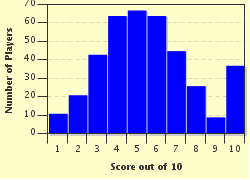Quiz Answer Key and Fun Facts
1. What is the common name for the finger known as the digitus medicinalis?
2. Which of the following things happens to the finger joints if the hand becomes unable to move?
3. The palm of the hand can be described as glabrous, which means which of the following things?
4. During the Gallic wars, Julius Caesar often ordered which of the following things done to the hands of captured soldiers?
5. Polydactyly is a disorder that manifests itself in which of the following ways?
6. When looking at your hands, where would you find your pollex?
7. There are no muscles in your fingers.
8. Your fingernails grow approximately 1/4 inch (6.35 mm) after you die.
9. Which of the following is the best description of your lunula?
10. Adermatoglyphia is a very rare medical condition which is characterized by which of the following?
Source: Author
dcpddc478
This quiz was reviewed by FunTrivia editor
CellarDoor before going online.
Any errors found in FunTrivia content are routinely corrected through our feedback system.


